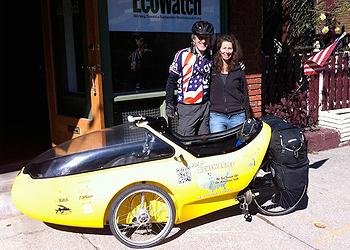
CLEVELAND, Ohio, October 15, 2013 (ENS) – Cycling along on his rocket trike, an anti-tar sands pipeline activist Monday left Cleveland heading for the White House to deliver a petition calling on President Barack Obama to stop construction of an oil pipeline from Cushing, Oklahoma to the Texas Gulf Coast.
Tom Weis’ “Ride for Renewables” journey of 485 miles symbolizes the 485-mile section of the pipeline that he calls the “Keystone XL pipeline’s southern leg” but that its builder, TransCanada Corporation, calls “the Gulf Coast Pipeline Project.”

TransCanada says the US$2.3 billion pipeline will be ready for commercial operation before the end of this year.
Initially, the pipeline is expected to carry 700,000 barrels a day of crude oil. Eventually, it could transport 830,000 barrels a day of oil extracted from the Canadian tar sands in northern Alberta to refineries at Nederland, Texas.
TransCanada is the company that has twice applied for a Presidential Permit to construct and operate the Keystone XL pipeline from Hardisty, Alberta to Cushing. Because it crosses the Canada-U.S. border the President must determine that the pipeline is in the national interest.
Slowed by investigations into conflict of interest on the part of two contractors who wrote Environmental Impact Statements for the U.S. state Department, that determination is not expected until next year. If the Keystone XL pipeline is approved, tar sands oil would move through pipelines all the way from Alberta to the Gulf Coast.
Weis, and the more than 7,000 people from all 50 states and many nations who signed the petition he carries, worry that extracting, processing and burning the heavy bitumen extracted from the Alberta tar sands will accelerate climate change.

“The urgency of our economic and planetary meltdown demands a modern-day green energy ‘moon shot’ for America,” said Weis. “It’s time for our generation to stand up and do something great.”
Weis set out on his velomobile, a recumbent tricycle wrapped in a lightweight aerodynamic shell, from the Cleveland office of EcoWatch, an environmental advocacy group that support his message.
Stefanie Spear, founder and CEO of EcoWatch, said, “Stopping the construction of the southern leg of the Keystone XL pipeline is one of the most important steps in preventing irreversible damage to our climate.”
Spear and others warn that the pipeline would accelerate the growth of one of the most polluting fuels on the planet.
The tar sands are vast deposits of bitumen, a tar-like substance turned into oil through energy- and water-intensive processes that damage the environment. So heavy that it cannot flow through a pipeline, the bitumen is diluted with lighter hydrocarbons for pipeline transport.
Weis describes Keystone XL’s 485-mile southern leg as “a linchpin for expanded tar sands development.”
Former NASA climate scientist Dr. James Hansen signed the petition Weis is carrying. Writing in the “Los Angeles Times” in April, Hansen warned, “Researchers now say that the Alberta tar sands contain 360 to 510 billion tons of carbon – more than double that of all oil burned in human history. While only a fraction is considered economically recoverable right now, we humans are genius at finding new and better ways to dig junk out of the ground. Digging begets more digging. Once the big spigot is open, TransCanada will have every incentive to milk the massive tar sands basin for all it is worth.”
Global concentrations of greenhouse gases such as carbon dioxide, CO2, in the atmosphere now have reached 394 parts per million, up from 280 ppm before the Industrial Revolution and the highest levels seen in at least 800,000 years.
Critics of tar sands oil development estimate that producing and processing the heavy tar sands oil emits roughly 14 percent more greenhouse gases than the average oil used in the United States, raising the planetary temperature at a rapid rate.
“The amount of CO2 locked up in Alberta tar sands is enormous,” says mechanical engineer John Abraham of the University of Saint Thomas in Minnesota, who signed a Keystone protest letter from scientists in January. “If we burn all the tar sand oil, the temperature rise, just from burning that tar sand, will be half of what we’ve already seen.”
Lester Brown, president of the Earth Policy Institute in Washington, DC, also signed Weis’ petition.
“At a time when the climate crisis demands an emergency response of 80 percent carbon cuts by 2020, our political leaders are instead embracing ever more extreme fossil fuels project like the Keystone XL tar sands pipeline in Texas and Oklahoma,” said Brown. “We need to be shooting for the moon with renewable energy, not drilling our way deeper into the climate hole.”
President Obama has indicated that he may not sign the Presidential Permit for TransCanada. On June 25, the President said, “Allowing the Keystone pipeline to be built requires a finding that doing so would be in our nation’s interest. And our national interest will be served only if this project does not significantly exacerbate the problem of carbon pollution.”
Weis says his 2013 Ride for Renewables will conclude with an action outside the White House in early November, “where climate leaders will peaceably assemble to demand that President Obama stop the tar sands pipeline in its entirety.”
Copyright Environment News Service (ENS) 2013. All rights reserved.
© 2013, Environment News Service. All rights reserved. Content may be quoted only with proper attribution and a direct link to the original article. Full reproduction is prohibited.
